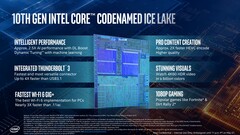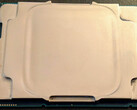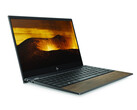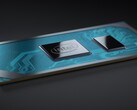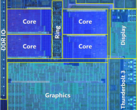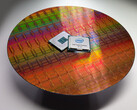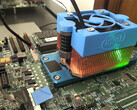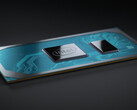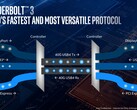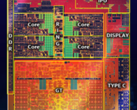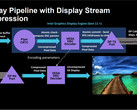With Intel finally getting ready to ship 10nm parts next month, the company offered more details into the 10th gen Ice Lake family at the ongoing Computex 2019 trade show. Ice Lake is slated to bring improvements in AI, faster integrated graphics, integrated Thunderbolt 3, Wi-Fi 6 Gig+, and more. The 10th gen Ice Lake will be also available in a 9W TDP multi-chip package in addition to the 15W and 28W TDPs.
Ice Lake architecture
Intel detailed the 10nm Sunny Cove architecture during its Architecture Day late last year. We are now getting to see how it all comes together in the new Ice Lake processors. Ice Lake offers a 4C/8T configuration with a maximum turbo boost up to 4.1 GHz on a scalable high bandwidth, low latency architecture. The new memory controller supports LPDD4x-3733 (up to 32 GB) or DDR4-3200 RAM (up to 64 GB) so we might see ultrabooks offering RAM capacities that are generally enthusiast or gaming notebooks territory. Graphics has received a major boost with integrated Gen11 that can offer 1 TFLOP of graphics performance with up to 64 EUs and a maximum clock of 1.1 GHz. There are also dedicated media encoders for processing 4K60 and 8K30 videos along with three display pipes that can output up to 5K60 or 4K120 outputs. Ice Lake also features a dedicated IPU 4 for still photo capture up to 16 MP and video recording at 1080p120 or 4K30.
Ice Lake's PCH continues to be fabbed on the 14nm process and Intel is integrating an upgraded Wi-Fi 6 Gig+ CNVi, power delivery, audio, and an x16 PCIe Gen3 amongst other I/O onto the PCH itself. OEMs will be able to offer Ice Lake in two primary BGA packages — a 15W Type 3 and a 9W Type 4. Since most components are integrated onto either the CPU or the PCH, OEMs will be able to offer much thinner and lighter yet fairly powerful notebooks.
Improvements to IPC and AI
Intel has increased the L1 cache size in the new Ice Lake CPUs and Sunny Cove can offer up to 50% increased L1 cache compared to Skylake i.e. Ice Lake CPUs offer 48 KB of L1 cache vis-a-vis Skylake's 32 KB. Intel claims a an 18% improvement in IPC compared to Skylake thanks to two additional reservation stations (total of four) and 10 dispatch ports. So in essence, each cycle can now dispatch five instructions compared to Skylake's four. Sunny Cove also offers improved branch prediction and reduced load latency. Additional vector capabilities help improve AI performance by up to 2.5x with Intel DL Boost.
All this should translate into better single-thread performance and optimization of specialized workloads that leverage the new crypto and vector instructions. Support for frameworks such as Windows ML, Intel OpenVino, and Apple CoreML are built-in. Intel showed off a few demos of the improved AI capabilities helping with local inference for semantic search in the Microsoft Photos app and in adding effects in CyberLink PhotoDirector 10 and PowerDirector 17.
What is interesting is that Intel is making use of machine learning to improve processor tuning depending on the workload. As seen in the final graph below, the Dynamic Tuning 2.0 uses ML to predict the workload and adjust the Tau time period accordingly. Therefore, the processor can run longer at PL2 turbo boost before returning to PL1 base clock. The fall from PL2 to PL1 can be staggered allowing for comparatively longer Tau periods depending on the available thermal budget. Thus, we can expect to see longer turbo boost intervals and better sustained performance with minimal throttling when subjected to heavy workloads. Of course, a lot depends on how well OEMs design the chassis so this one area where Intel's Project Athena could be of some use.
Source(s)
Intel Press Release


 Deutsch
Deutsch English
English Español
Español Français
Français Italiano
Italiano Nederlands
Nederlands Polski
Polski Português
Português Русский
Русский Türkçe
Türkçe Svenska
Svenska Chinese
Chinese Magyar
Magyar

